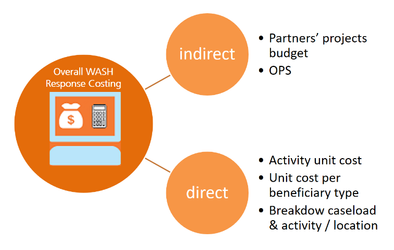WASH response costing
Estimate the overall WASH response funding requirements
The HRP is also a funds raising appeal document, where funding requirements of each cluster are presented separately and consolidated to form the total funding requirement for the response. Each sector coordinator is responsible to estimate the budget needed to implement the sectorial strategy for the coming year/phase. This is a complicated task as many parameters must be considered, and many variables are still unknown during planning phase (material cost, logistic cost...), which can change the overall budget. Nevertheless, response costing must be done quickly enough for funding to be allocated without delay. Even when costs are roughly estimated, it is important to be transparent and be able to explain how it was calculated. Cluster response budgets also represent targets against which funding allocation level will be regularly measured. Such monitoring of the funding status is used to advocate for further efforts in resource mobilization throughout the response.
| Response costing method |
As shown in the diagram above, there are two ways for WASH Cluster coordinators to estimate WASH response budget:
1- Indirect costing: In protracted emergencies (usually around September), partners are requested to upload a summary of their planned projects for the next year on the OPS website. Cluster coordinators can be asked to pre-validate projects on OPS to make sure they meet minimum criteria. Operational Response Plan’s costs can be calculated by adding up requested budgets from all approved partner’s planned proposals. The positives and negatives aspects of this method include:
- Pros: quick, participatory; field oriented; partners can in theory factor in their capacity
- Cons: can be very inaccurate because:
-Partners have tendency to overestimate their funding requirements, and not factor in difficult access, or their capacity gap
-Difficult to estimate geographic/program overlapping. Partners will not do it between themselves, as they are in competition for funding
-Subjective, based on partner’s estimation
2- Direct costing: The WASH Cluster coordinator use caseload figures, priority activities and unit costs to estimate total response budget themselves. Activities/beneficiaries' unit costs can be estimated directly, or taken from partners’ former projects’ final report (final reports’ budget are preferred to proposal ‘s budget, as costs are more accurate).
- Pros: apparent accuracy; Can provide further guidance to partners’ proposal evaluation in terms of unit cost; Help to evaluate future projects' cost. Based on population figures/caseload, so access and capacity already factored in.
- Cons: time consuming for cluster cooridnators; based on population figures that are sometimes inaccurate ; not participatory ; unit cost are usually only approximate, and vary from one place to another.
Note on Direct Costing
- Caseload figure must be broken down per activity, as not all people will be reached by all the activities
- Activities must be broken down per geographical location, as needs are not the same by location
- Unit costs must be broken down per geographical location (for instance, prices can vary greatly based on access)
- If done precisely, direct costing can be a tedious task, so depending on time available, rough estimations can be used, as long as they are well explained
- Direct estimation can be especially interesting in case of small geographical scale emergency (localized refugee/IDP camps...)
- It can be interesting to use both direct and indirect methods, and compare one with the other to find the right balance. In that way, cluster coordinator do not rely 100% on partners' estimation, and have a way to compare them with her/his own calculation
Key web links
OPS (Online Project System), where cluster partners are requested to upload a summary of their planned project for next year
